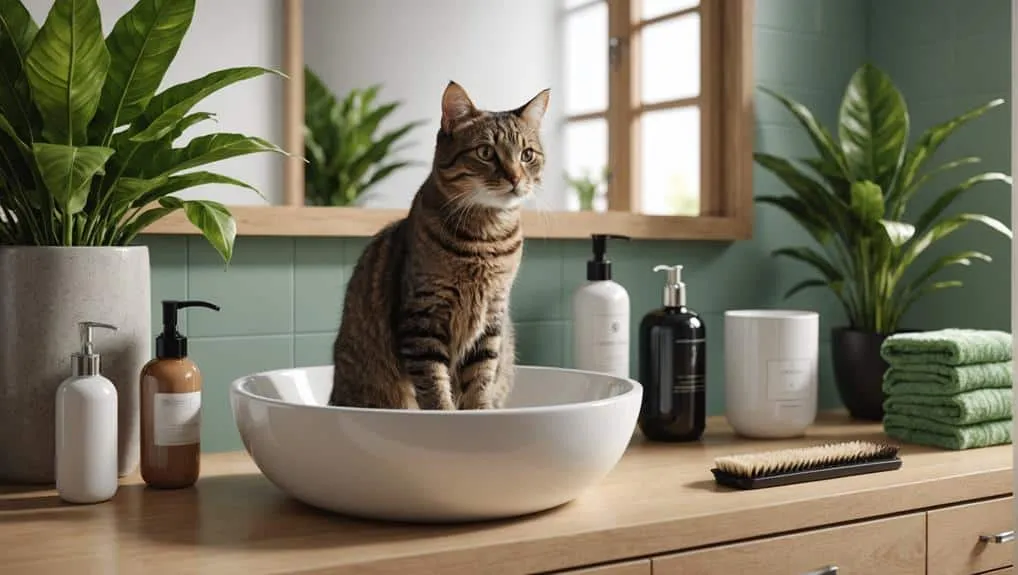The Best Fluffy Pancakes recipe you will fall in love with. Full of tips and tricks to help you make the best pancakes.

Getting your cat comfortable with bath time takes some preparation. Start by letting them explore the bathroom at their own pace. This will help them get used to the new surroundings.
Next, introduce the sound of running water – it might be startling at first, but with treats and praise, they'll learn to associate it with positive experiences.
Make sure you have everything you need before you start, like a gentle cat shampoo and some large, absorbent towels.
When it's time for the bath, prioritize your cat's safety and comfort. If they seem stressed or anxious, be prepared to adjust your approach.
With the right strategy, you can make bath time a success. Then, you can focus on the finer details.
Understanding Cat Bathing Needs
When it comes to taking care of your cat, figuring out their bathing needs is pretty important. These needs can vary a lot depending on factors like their breed, age, and health issues. Generally, cats are pretty good at keeping themselves clean, so they don't need baths all the time.
However, there are some situations where you'll need to give your cat a bath. For example, if you have a longhaired cat like a Persian, they might need a bath every now and then to prevent their fur from matting and to keep their coat clean. Senior or obese cats might also need baths because they can't move around as easily and can't groom themselves as well.
On the other hand, hairless cats like the Sphynx need to be bathed more often, about every 1-2 weeks. This is because they have excess skin oils that need to be managed. The thing is, you have to be careful when bathing your cat because doing it too much can strip the natural oils from their coat, which can cause skin irritation.
Preparing Your Cat for Bathing
So, you want to bathe your cat?
Well, before you do, it's really important to get them comfortable with the whole process. Cats can get pretty stressed out about baths, so it's essential to introduce them to the bath environment slowly.
Start by letting your cat explore the bathroom or wherever you'll be bathing them. Let them get used to the sights, sounds, and smells of the area.
Then, you can start introducing them to water gradually. There are techniques like gradual exposure methods that can help make this process easier.
Water Familiarization Techniques
To help your cat feel comfortable with water, start by introducing them to small amounts in a controlled environment, like a shallow bowl or sink. Let them explore and get used to the sensation at their own pace. This is key to reducing anxiety during bath time.
When you first start, just put a few drops of water on their paws. See how they react, and if they seem okay, you can gradually add a bit more water. The goal is to keep them calm throughout the process. Be sure to give them treats and praise when they do well, so they start to associate water with positive things.
Next, try gently dampening a washcloth and letting your cat feel the moisture on their paws. This will help them get comfortable with the feeling of water on their skin. You should also play with your cat in the bathroom, so they get used to the sounds of running water. This will help reduce anxiety during bath time.
Gradual Exposure Methods
Now that your cat is comfortable with small amounts of water, it's time to take things to the next level. You want to get them used to more water and the sensations that come with bathing.
Start by letting your cat explore shallow bowls or dishes filled with a small amount of water. Do this over several days or weeks, so they can get comfortable at their own pace.
As they become more relaxed, it's time to introduce the sound of running water. Let them hear it from a distance at first, and then gradually move closer as they become more comfortable with the noise.
Next, try gently misting or lightly wetting their paws with a damp cloth. This helps create a positive association with water exposure without overwhelming them. You can use toys, treats, or positive reinforcement to encourage your cat to engage with water, making the experience fun and playful.
To create a calm environment, try playing soothing music or using soft voices while preparing for the bath. This helps your cat feel relaxed and less anxious.
Bath Environment Preparation
To set up a calming and secure bathing space, you'll want to select a quiet and comfortable location. This could be a kitchen or bathroom sink, as it will help minimize distractions and reduce your cat's anxiety during the bath. This, in turn, will help your cat feel more at ease and make the bathing process less stressful.
When it comes to preparing the bathing area, there are a few key steps to follow.
Choose a location that works best for you and your cat. A quiet, comfortable location, such as a kitchen or bathroom sink, is ideal.
Next, fill the bathing area with 2-3 inches of lukewarm water to avoid shocking your cat. This will help them feel more comfortable and secure.
Providing stability is also crucial. Lay down a nonslip mat or towel in the sink or tub to prevent your cat from slipping or falling.
Make sure you have all the necessary supplies within easy reach. This includes cat-specific shampoo, towels, and washcloths.
Essential Bathing Supplies and Equipment
When it comes to bathing your cat, having the right supplies is crucial for a safe and stress-free experience.
You'll need some essential items, like a gentle cat shampoo that won't irritate their skin. A large towel is also a must-have for drying your cat off afterwards.
A nonslip mat in the bottom of the bathtub or sink is also a good idea, as it'll help prevent your cat from slipping and falling.
You'll also need a pitcher or cup to gently pour water over your cat. Some treats can come in handy too, as a little reward can go a long way in making the experience less stressful for your cat.
With these supplies, you'll be well-equipped to handle bath time with confidence.
Cat Shampoo and Towels
When it comes to bathing your cat, there are two essential supplies you need to make the experience safe and stress-free: a gentle, cat-specific shampoo and a bunch of absorbent towels.
For shampoo, you'll want to choose a mild, soap-free, and hypoallergenic one that's formulated for your cat's unique skin pH. This reduces the risk of irritation and allergic reactions. Remember, human or dog shampoo is a no-go – they can cause harmful reactions.
For towels, go for large, absorbent ones that can quickly dry your cat after bathing. This reduces their exposure to cold. It's a good idea to have these supplies within easy reach before starting the bath. This streamlines the process and reduces stress for both you and your cat.
Bathing Mat and Pitcher
When it comes to bathing your cat, a good bathing mat is essential. The textured surface provides critical grip and stability, preventing slips and potential injuries during the bathing process. This means your cat will feel secure and stable, allowing you to bathe them with confidence.
Another necessary supply you'll need is a pitcher or cup. This is perfect for scooping and pouring water over your cat, allowing for more controlled wetting without overwhelming them. When choosing a pitcher, go for one with a gentle pouring spout. This will let you apply water gradually and comfortably, reducing the likelihood of startling your cat.
Remember to keep all your bathing supplies, including the mat and pitcher, within arm's reach. This way, you won't have to leave your cat unattended in the bathing area.
Step-by-Step Bathing Process Guide
So you want to bathe your cat safely and effectively. Here's how you can do it.
First, gently wet your cat's body from the shoulders to the tail using a spray nozzle or pitcher. This helps minimize stress and discomfort. Remember to keep the head dry to avoid getting water onto your cat's face and eyes.
Next, apply a cat-specific shampoo from the neck down. Be gentle when lathering to avoid any irritation. For your cat's face, use a damp cloth to clean it, taking care to avoid the eyes, nose, and mouth.
Now it's time to rinse your cat thoroughly to remove all shampoo residue. This is important because leftover residue can cause skin irritation. Use lukewarm water and avoid getting water into your cat's ears or eyes.
After rinsing, use a damp cloth to clean your cat's ears, being careful not to insert anything into the ear canal.
Finally, wrap your cat in a large towel to absorb excess water and keep them warm. If your cat is comfortable with the sound, you can use a hairdryer. But if not, it's best to avoid it.
Managing Stress and Anxiety During Baths
Bathing can be super stressful for cats, so it's crucial to take steps to manage their anxiety and make the experience as comfortable as possible. Cats need to feel secure and calm, and it's up to you to create that environment for them.
One way to do this is to gradually get your cat used to water. Let them explore the bathing area and play with shallow bowls or sinks over several days or weeks. This can help them become more comfortable with the idea of water.
Creating a soothing environment can also go a long way in reducing stress. Try using calming techniques like gentle tones, soft music, and treats to create a peaceful atmosphere during the bath.
It's also essential to keep an eye on your cat's behavior during the bath. If they start to show signs of panic, such as excessive stress, fear, or aggression, be prepared to stop the bath right away.
Post-Bath Care and Reward Strategies
So, you've made it through the bath with your cat. Now it's time to make sure they feel comfortable and relaxed afterwards.
First things first, gently pat them dry with a towel to prevent them from getting chilled and to remove excess water. This is a great opportunity to give them some treats and praise them for their good behavior. This positive reinforcement will help them associate baths with good experiences, making future baths less stressful for both of you.
As you're taking care of your cat, keep an eye out for any signs of discomfort or stress. Keep the bathroom door closed until they've calmed down to prevent them from making a run for it.
Regular grooming between baths can really help keep their coat clean and reduce the need for frequent baths. You might also want to consider using calming aids like pheromone sprays or diffusers during and after bath time to help reduce your cat's anxiety.
Safety Considerations and Alternative Methods
As you prepare to bathe your cat, their safety should be your top priority. You want to minimize stress and anxiety during the process, so make sure you have all the bathing supplies within reach. This way, you won't have to leave your cat unattended, which can cause them to feel scared or try to escape.
It's also important to stay calm, as your cat can pick up on your energy and become more anxious if you're stressed. Wearing protective clothing is a good idea too, in case your cat gets scratched or tries to defend themselves.
When it comes to safety, there are a few things to keep in mind. Firstly, prevent your cat from escaping the bathing area, as this can lead to injuries or trauma. Secondly, monitor your cat's anxiety levels – if they're showing signs of excessive fear or aggression, it's best to stop the bath right away.
Finally, avoid causing your cat any traumatic experiences, especially if they've had bad experiences with baths in the past. If that's the case, it's a good idea to consult with a vet for advice on safe and gentle grooming practices.
If traditional bathing isn't an option for your cat, don't worry – there are alternative methods you can try. For example, you can use cornstarch to absorb oil from their coat, or use a wet washcloth for targeted cleaning.
If your cat has complex grooming needs or is extremely anxious, it might be better to leave it to a professional groomer. By prioritizing your cat's safety and well-being, you can ensure a positive and stress-free bathing experience.
Maintaining a Healthy Coat and Skin
Regular grooming sessions can make a huge difference for your cat's coat and skin health. By brushing your cat regularly, you'll remove loose fur, dirt, and allergens, which leads to a healthier coat and reduces the need for baths. This is especially important for long-haired breeds like Persians or Maine Coons, which can get matted and tangled if not groomed frequently. This can cause skin irritation, so it's essential to stay on top of it.
If your cat has skin conditions, using the right shampoo can make a big difference. Just make sure to get a veterinary-approved shampoo to maintain skin health and coat quality. But remember, too many baths can be bad news. They can strip your cat's skin and fur of natural oils, leading to dryness and irritation. So, only bathe your cat when it's really necessary.
A healthy diet and plenty of water are also crucial for your cat's skin and coat health. Make sure your cat is getting enough Omega-3 fatty acids, which will enhance their overall appearance and wellness. By following these tips, you'll be well on your way to helping your cat achieve a healthy coat and skin, making bath time a whole lot easier.
Frequently Asked Questions
How to Prepare a Cat for a Bath?
Preparing your cat for a bath can be a daunting task, but it's crucial to get it right. To reduce your cat's stress levels, start by gently grooming them. This will help them get comfortable with your touch and build trust.
Positive reinforcement is also key. Reward your cat with treats and praise when they behave calmly. This will help them associate the bathing process with positive outcomes.
Next, introduce water gradually. You can start by simply placing your cat's paws in water or using a damp cloth to wipe their fur. This will help them get used to the sensation.
Make sure you have all the essential bath supplies ready. You'll need a suitable shampoo, towels, and a washbasin or tub.
It's also vital to ensure the water is at a comfortable temperature for your cat. Test it with your hand to make sure it's not too hot or cold. By following these steps, you can create a calm and stress-free bathing experience for your cat.
Should You Brush a Cat Before or After a Bath?
So you're wondering when to brush your cat – before or after a bath? Well, the answer is, you should do it both times! Brushing before a bath helps remove tangles and reduces shedding, which makes the whole bathing process a lot easier. It also prevents matting, which can be painful for your cat.
After the bath, brushing again is important to remove any remaining tangles and to get their fur looking nice and smooth. Plus, it helps distribute natural oils throughout their coat, which keeps it healthy and shiny. Of course, you'll want to consider your cat's fur type, the tools you're using, and how they react to brushing and baths in general. But overall, brushing before and after a bath is a great way to maintain a healthy grooming routine and keep your cat's coat looking its best.
How to Give Your Cat a Bath Without Them Freaking Out?
So, you want to give your cat a bath without them totally freaking out. First, you should try to reduce their stress levels. You can do this by using calming techniques, like gentle petting or soothing music. Make sure the water is lukewarm, not hot or cold, and choose a gentle soap that's meant for cats.
When you're actually bathing your cat, be gentle and move slowly. Try not to get water in their ears, eyes, or nose. You can also try to make the experience more enjoyable by giving them treats or toys.
After the bath, use a towel to dry your cat thoroughly. This will help prevent them from shaking, which can be really stressful for them. You should also keep an eye on your cat's behavior after the bath to make sure they're recovering smoothly. If they seem really upset or stressed, you might want to try to make the experience better next time.
How Often Should I Bathe an Indoor Cat?
So, how often should you bathe your indoor cat? Well, the answer is simple: only as needed. You see, over-bathing can strip your cat's coat of its natural oils, which can lead to dryness and irritation. On the other hand, under-bathing can cause skin issues like dirt buildup and oiliness.
To determine when your cat needs a bath, consider a few things. First, think about how often your cat grooms itself. If your cat is meticulous about its cleanliness, it might not need a bath as frequently. Next, take a look at your indoor environment. If your home is particularly dusty or dirty, your cat might need a bath more often to stay clean. Finally, keep an eye on your cat's skin health. If you notice any skin issues like dandruff, itchiness, or redness, a bath might be in order.
Final Thoughts
You've made it! By following these steps, you've set yourself up for a stress-free and safe bathing experience for your cat.
Remember, it's essential to reward good behavior and maintain a healthy coat and skin through regular grooming.
If needed, consider alternative methods that might work better for your feline friend.
With time and practice, you'll get the hang of bathing your cat, and who knows, they might even learn to tolerate – or dare we say, enjoy – the process.








